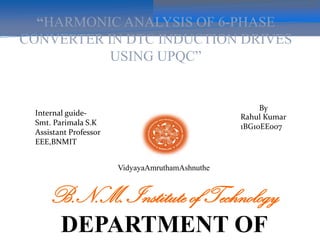harmonic analysis of 6 phase converter
- 1. ŌĆ£HARMONIC ANALYSIS OF 6-PHASE CONVERTER IN DTC INDUCTION DRIVES USING UPQCŌĆØ B.N.M. Institute of Technology DEPARTMENT OF VidyayaAmruthamAshnuthe Internal guide- Smt. Parimala S.K Assistant Professor EEE,BNMIT Rahul Kumar 1BG10EEo07 By
- 2. OVERVIEW ’éŚIntroduction ’éŚDirect torque control technique ’éŚDTC controller ’éŚDTC control scheme ’éŚModel of UPQC ’éŚConclusion
- 3. IntroductionThecomplete block diagram of motor drive is shown in the Fig. 1. The Controlled electrical drives are made up of several parts: the electrical machine, the power converter, the control equipment and the mechanical load.
- 4. ’éŚIn DTC it is possible to control directly the stator flux and the torque by selecting the appropriate inverter state. ’éŚTheloads based on power electronic devices generally pollute the nearby network by drawing non sinusoidal cur-rents from thesource Therapid switching of electronic devices creates additional Problems. ’éŚOneof the bestsolutionto compensate both current and voltage related problems, simultaneously, is the use of Unified Power Quality Conditioner (UPQC).One of the electrical system adapter structures is back toback inverter.
- 5. DIRECT TORQUE CONTROL TECHNIQUE ’éŚIn Direct Torque Control it is possible to control directly the stator flux and the torque by selecting the appropriate inverterstate.
- 6. ’éŚBecause of the rotor time constant is larger than the stator one, the rotor flux changes slowly compared to the stator flux; in fact, the rotor flux can be assumed constant. The fact that the rotor flux can be assumed constant is true as long as the response time of the control is much faster than the rotor time constant. ’éŚAs long as the stator flux modulus is kept constant, then the electromagnetic torque can be rapidly changed and controlled by means of changing theangle(Žüs -Žür).
- 7. DTC CONTROLLER ’éŚThe way to impose the required stator flux is by means of choosing the most suitable Voltage Source Inverter state. ’éŚIf the ohmic drops are neglected for simplicity, then the stator voltage impresses directly the stator flux in accordance with the following equation: ’éŚIfan increase of the torque is required then the torque is controlled by applying voltage vectors that advance the flux linkage space vector in the direction of rotation. If a decrease in torque is required then zero switching vector isapplied.
- 9. DTC CONTROL SCHEME Direct Torque Control schematic diagram
- 10. ’éŚAs it can be seen, there are two different loops corresponding to the magnitudes of the stator flux and torque. The reference values for the flux stator modulus and the torque are compared with the actual values and the resulting error values are fed into the two level and three-level hysteresis blocksrespectively. ’éŚThestator flux modulus and torque errors tend to be restricted within its respective hysteresis bands. It can be proved that the flux hysteresis band affects basically to the stator-current distortion in terms of low order harmonics and the torque hysteresis band affects the switchingfrequency.
- 12. OUTPUT WAVEFORM OF SIX PULSE RECTIFIER INPUT CURRENT OF RECTIFIER
- 13. MODEL OF UPQC ’éŚOneof the best solution to compensate both current and voltage related problems simultaneously, is the use of Unified Power Quality Conditioner (UPQC). One of the electrical system adapter structures is back to back inverter. According to the controlling structure, back to back inverters might have different operations in compensation. For example, they can operate as shunt and series active filters to simultaneously compensate the load current, harmonics and voltage isolation. This is called UPQC. EQUIVALENT CIRCUIT OF UPQC
- 14. CONCLUSION ’éŚThe drive drives a load according to the requirements based on their parameters. Here the used drive is induction motor drive which matches itŌĆÖs load and speed to the given reference load, torque and speed values. ’éŚThematching of these reference values to the output values of the drive is mainly depend on the control technique used in the drives. Here DTC technique is used and for minimizing harmonics unified power quality conditioner is used.














